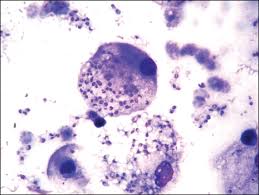What's in this article?
What is Histoplasmosis?
Histoplasmosis is an infection caused by a fungus called Histoplasma. The fungus lives in the environment, particularly in soil that contains large amounts of bird or bat droppings. In the United States, Histoplasma mainly lives in the central and eastern states, especially areas around the Ohio and Mississippi River valleys. The fungus also lives in parts of Central and South America, Africa, Asia, and Australia.
People can get histoplasmosis after breathing in the microscopic fungal spores from the air. Although most people who breathe in the spores don’t get sick, those who do may have a fever, cough, and fatigue. Many people who get histoplasmosis will get better on their own without medication, but in some people, such as those who have weakened immune systems, the infection can become severe.
Symptoms of Histoplasmosis
Several types of histoplasmosis exist. The mildest form produces no signs or symptoms, but severe infections can be life-threatening. When signs and symptoms do occur, they usually appear three to 17 days after exposure and may include:
- Fever
- Chills
- Headache
- Muscle aches
- Dry cough
- Chest discomfort
In some people, histoplasmosis can also produce joint pain and a rash. People who have an underlying lung disease, such as emphysema, may develop a chronic form of histoplasmosis.
Symptoms of chronic histoplasmosis may include weight loss and a cough that brings up blood. The symptoms of chronic histoplasmosis sometimes can mimic those of tuberculosis.
Causes of Histoplasmosis
Fungal spores can be released into the air when contaminated soil or droppings are disturbed. Breathing the spores may lead to an infection.
The spores that cause this condition are commonly found in places where birds and bats have roosted, such as:
- caves
- chicken coops
- parks
- older barns
You can get histoplasmosis more than once. However, the first infection is generally the most severe.
The fungus doesn’t spread from one person to another and it’s not contagious.
What are risk factors for Histoplasmosis?
Anyone may develop histoplasmosis. However, the illness is more likely to occur in infants, young children, and the elderly. People with suppressed immune function or chronic lung disease are also at increased risk for severe (disseminated) disease. The soil may also become contaminated with the fungus, so those who work with soil, such as landscapers and farmers, are at greater risk. Also at risk are workers performing demolition work in areas that may be contaminated with bird or bat droppings.
Treatment for Histoplasmosis
For some people, the symptoms of histoplasmosis will go away without treatment. However, prescription antifungal medication is needed to treat severe histoplasmosis in the lungs, chronic histoplasmosis, and infections that have spread from the lungs to other parts of the body (disseminated histoplasmosis). Itraconazole is one type of antifungal medication that’s commonly used to treat histoplasmosis. Depending on the severity of the infection and the person’s immune status, the course of treatment can range from 3 months to 1 year.
When to see a doctor
Contact your doctor if you develop flu-like symptoms after being exposed to bird or bat droppings especially if you have a weakened immune system.






I’m try to get what kind of skin problem I have ,my skin when the weather is hot it’s cover by red colour and after that the red spot change to dark n back to normal change tell what wrong to my skin it’s look like my skin not good for the sun